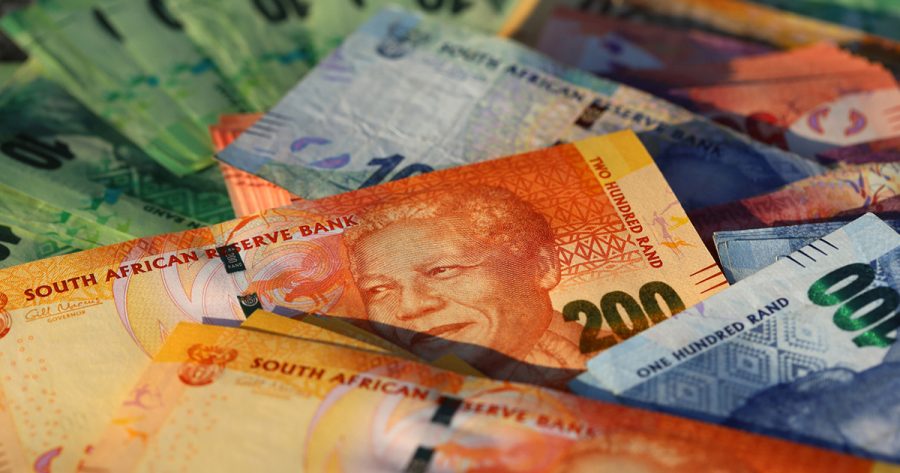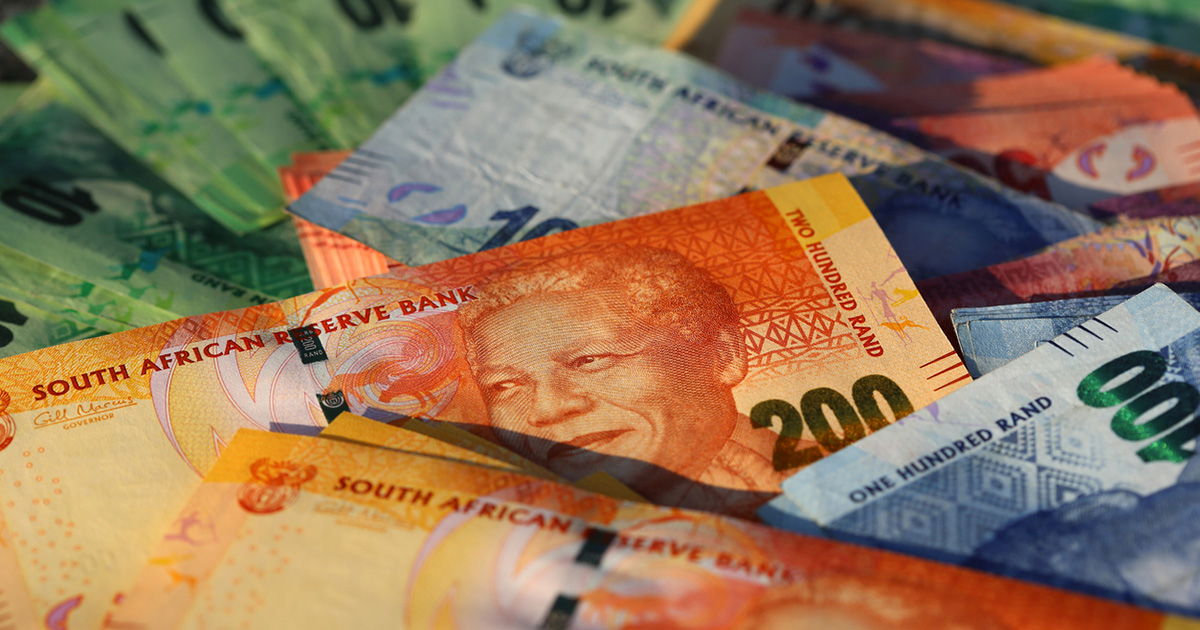
South African rand dropped after central bank holds interest rates
Reuters: The South African rand dropped on Thursday afternoon after the central bank held its key interest rate at 8.25% following 10 consecutive rate hikes since 2021, as expected by a majority of economists polled by Reuters. SOUTH AFRICAN RAND DROPS At 1323 GMT, the rand traded at 17.915 against the U.S. dollar, around 0.25% […]

Reuters: The South African rand dropped on Thursday afternoon after the central bank held its key interest rate at 8.25% following 10 consecutive rate hikes since 2021, as expected by a majority of economists polled by Reuters.
SOUTH AFRICAN RAND DROPS
At 1323 GMT, the rand traded at 17.915 against the U.S. dollar, around 0.25% weaker than its previous close. At one point it was down as much as 0.53% as the currency reversed gains made earlier in the day.
ALSO READ: REMINDER | Interest rate: How much your bond costs every month
Twelve out of 21 economists in a Reuters poll published last week expected the bank would hold its rate at 8.25%, while nine economists predicted a 25 bps hike. The South African Reserve Bank had been on a rate-hiking cycle since September 2021, raising the repo rate by a total of 475 basis points (bps). Consumer inflation data on Wednesday showed inflation fell to 5.4% year-on-year in June, down from 6.3% in May and back within the central bank’s target range of 3% to 6% for the first time in over a year.
“SA June inflation at 5.4% was lower than consensus but on our forecast. To us this affirms the SARB MPC will not have to hike today,” Rand Merchant Bank analysts had said in a research note before the rate decision. The dollar was up about 0.2% against a basket of global currencies after U.S. jobless claims unexpectedly fell, pointing to strength in the labour market. This raised expectations that Federal Reserve monetary policy will stay tighter for longer, pressuring other currencies globally.
ALSO READ: 22 nations seek to join BRICS bloc as summit approaches
South Africa’s benchmark 2030 government bond ZAR2030= was slightly stronger, with the yield down 1.5 bps to 10.29%.
BRITISH POUND
Reuters: Sterling continued its slide against the euro and dollar on Thursday as the UK’s declining inflation pulled back market expectations of further aggressive rate hikes from the Bank of England (BoE). Against the euro, sterling fell 0.3% to 86.84 pence, heading towards the two-month low it touched on Wednesday. It was set for its biggest one-week drop since February 2. The Sterling was last down 0.2% against the dollar at $1.2914, set for its fifth consecutive daily drop against the greenback, after falling 0.74% on Wednesday.
Data showed on Wednesday that British annual consumer price inflation fell to a much lower than expected 7.9% in June. Economists polled by Reuters had forecast the CPI rate in the 12 months to June would drop to 8.2% from May’s 8.7%. Money markets lowered their expectations for BoE rate hikes, with the prospect of UK rates rising above 6% now likely off the table. Jeremy Stretch, head of G10 FX strategy at CIBC Capital Markets, said he expects the sterling to remain above the lows of $1.2867 hit on Wednesday. “Rates are now barely expected to exceed 5.75%, this compares with assumptions of rates exceeding 6.50% two weeks ago,” Stretch said. But “we would expect ongoing rate support to maintain a degree of sterling support,” he adds.
ALSO READ: Elon Musk loses R363 billion in 24 hours as Tesla shares tumble
The UK still has the highest inflation of the G7. In the United States, headline consumer price pressures are running at a rate of just 3%, while euro zone inflation is at 5%. Wholesale energy prices have fallen sharply this year, which has offered consumers and businesses some respite, but mortgage rates are rising fast and grocery inflation is still in double digits. BoE Deputy Governor Dave Ramsden said inflation still showed risks of longer-term stickiness.
U.S. DOLLAR
Reuters: The dollar was steady on Friday as data pointed to U.S. labour market resilience that could lead the Federal Reserve to keep interest rates higher for longer, while the yen wobbled after Japan’s core consumer inflation re-accelerated in June. Central bank meetings from Europe, Japan and the United State are due next week, with investors parsing through data to better gauge monetary policy paths they will likely chart.
ALSO READ: The authentication of documents and apostilles
The Japanese yen was at 140.10 per dollar, flat for the day, after nationwide core consumer price index rose 3.3% in June from a year earlier, matching a median market forecast, but remained above the Bank of Japan’s 2% target. The data bolsters the chances the BOJ will revise up this year’s inflation forecast in fresh projections due next week. Carol Kong, a currency strategist at Commonwealth Bank of Australia (CBA), said the market expectations for a BOJ policy tightening have ebbed and flowed over the past year. “The window for the BOJ to tighten policy is narrowing,” Kong said, adding that CBA’s base case is for the BOJ to keep monetary policy unchanged this year.
BOJ Governor Kazuo Ueda earlier this week said Japan was still distant from sustainably achieving the bank’s 2% inflation target, dousing speculation that a tweak to yield curve control was on the cards next week. More than three-quarters of economists polled by Reuters expect the BOJ to hold policy steady including its yield control scheme. The yen has slipped about 1% against the dollar this week and is on course to snap its two-week winning run.
ALSO READ: Who is the richest person in the world today? Top 10 list – 21 July 2023
Sterling last fetched $1.2881, up 0.12% on the day and was set to snap its 5-day losing streak. Investor focus will be on Britain’s retail sales data for June on Friday. Meanwhile, data overnight showed the number of Americans filing new claims for unemployment benefits unexpectedly fell last week, touching the lowest level in two months amid ongoing labour market tightness. Markets expect a 25 basis point hike from the Fed next week and the odds of the U.S. central bank to continue raising rates nudged up after the data. “We could see the last rate hike in this cycle, but any dovish pivot seems far out,” Christian Scherrmann, U.S. economist at DWS, said. “This gains importance as it seems like markets might be a bit over-optimistic on recent ‘good’ inflation news.”
Against a basket of currencies, the dollar was at 100.75, holding on to its overnight gain of 0.5%. The index is on course for a 1% gain in the week. The euro rose 0.1% to $1.1141, having dropped 0.6% on Thursday. The European Central Bank is expected to raise interest rates by 25 basis points on July 27, according to all economists in a Reuters poll, a slight majority of whom were now also expecting another hike in September. The onshore yuan firmed against the dollar and was last at 7.1693 per dollar after the central bank set a much stronger guidance than expected. The Australian dollar was flat at $0.678, while the kiwi eased 0.18% to $0.622.
ALSO READ: BREAKING: SA Reserve Bank keeps interest rates on hold
GLOBAL MARKETS
Reuters: Asian shares were subdued on Friday after earnings reports from Tesla and Netflix failed to dazzle, while the dollar and Treasury yields held gains ahead of an action-packed week that could see the end of the U.S. tightening cycle. European shares were set for a lower open, with EUROSTOXX 50 futures off 0.3%. S&P 500 futures and Nasdaq futures were up 0.1%. As well as the U.S. Federal Reserve and European Central Bank meetings next week, the Bank of Japan will meet amid speculation of imminent policy tweaks. Early on Friday, Japan’s inflation stayed above the central bank’s target of 2% for the 15th straight month in June, but gains matched a median market forecast.
MSCI’s broadest index of Asia-Pacific shares outside Japan slipped 0.5%, heading for a weekly loss of 1.8%. Japan’s Nikkei, meanwhile, lost 0.6%. A technology sub-index slid 2.2%. Shares of Taiwanese chipmaker TSMC slumped 3.3%, after the world’s largest contract chipmaker flagged a 10% drop in 2023 sales. China’s blue chips wobbled 0.2% while Hong Kong’s Hang Seng index gained 0.4%. The yuan was range-bound on Friday after authorities stepped up efforts to defend a weakening currency, alongside yuan-buying trades by state-owned banks. Concerns are also brewing over the health of Chinese property developers, after rating agencies warned Wanda Commercial could default on its debt repayment. Dollar bonds of Country Garden tumbled on Friday.
ALSO READ: Newspaper front pages from around the world, 21 July 2023
“China’s property sector has entered its longest downtrend in the past two decades and the worst may not be over,” said Betty Wang, senior China economist at ANZ. “At the current stage, there is no single panacea available. Multi-pronged efforts are needed to prevent further slides.” Anticipation for more policy support is building ahead of the politburo meeting at the end of July. Beijing on Friday released some new measures to help auto and electronics consumption, which failed to generate much excitement in the market.
On Wall Street, after rallying almost 40% since the turn of the year, the Nasdaq fell 2% overnight, the biggest one-day loss since March, driven by steep post-earnings plunges in mega tech stocks Tesla and Netflix. The electric-vehicle maker reported a drop in its second-quarter gross margins to a four-year low while the streaming video company’s quarterly revenue fell short of estimates. Also, an unexpected fall in the U.S. weekly jobless claims fuelled expectations for a strong payrolls report, after markets braced for higher interest rates in the U.S. and Europe. They nudged up the chance of a second increase from the Fed by November to 33%, and slightly pared back the size of rate cuts next year to just under 100 basis points.
ALSO READ: Eskom ramps up load shedding starting NOW
Ten-year Treasury yields were mostly flat in Asia at 3.8487%, after spiking 11 basis points overnight, while two-years held at 4.8286%, having gained 8 bps overnight. The U.S. dollar index was little changed at 100.78, after advancing 0.5% overnight, the biggest one-day gain since mid-May. The Australian dollar gave up almost all of its gains made after a strong local jobs data release to hover below 68 cents. Markets are looking ahead to next week when Fed, the European Central Bank and the BOJ will be meeting to decide on their policy and debate the rate outlook. “While we anticipate that July will bring the Fed’s last rate increase of this cycle, we do not think the Fed is comfortable signalling that shift just yet. Rather, policymakers appear more comfortable maintaining a hawkish stance for now,” said analysts at TD Securities.
Elsewhere, oil prices were higher. Brent crude futures were up 0.8% at $80.27 per barrel and U.S. West Texas Intermediate crude futures rose 0.8% to $76.25. Gold prices were flat at $1,969.95 per ounce.
ALSO READ: On This Day in South Africa: What happened on 21 July?
